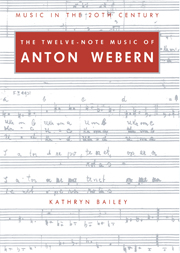Book contents
- Frontmatter
- Contents
- Acknowledgements
- Conventions in the text
- Introduction
- PART I Row and canon
- PART II The instrumental music
- Introduction to Part II
- 4 The movements in sonata form: Opp. 20/ii, 21/i, 22/i, 24/i and 27/i
- 5 The movements in variation form: Opp. 21/ii, 24/iii, 27/iii, 28/i and 30
- 6 The movements in rondo and ternary forms: Opp. 20/i, 22/ii, 24/ii, 28/ii and 28/iii
- 7 The movement in binary form: Op. 27/ii
- PART III The music with voices
- Conclusion
- Appendices
- Notes
- Glossary
- Chronological worklist
- Select bibliography
- Index
5 - The movements in variation form: Opp. 21/ii, 24/iii, 27/iii, 28/i and 30
Published online by Cambridge University Press: 23 December 2009
- Frontmatter
- Contents
- Acknowledgements
- Conventions in the text
- Introduction
- PART I Row and canon
- PART II The instrumental music
- Introduction to Part II
- 4 The movements in sonata form: Opp. 20/ii, 21/i, 22/i, 24/i and 27/i
- 5 The movements in variation form: Opp. 21/ii, 24/iii, 27/iii, 28/i and 30
- 6 The movements in rondo and ternary forms: Opp. 20/i, 22/ii, 24/ii, 28/ii and 28/iii
- 7 The movement in binary form: Op. 27/ii
- PART III The music with voices
- Conclusion
- Appendices
- Notes
- Glossary
- Chronological worklist
- Select bibliography
- Index
Summary
‘To develop everything else from one principal idea! That's the strongest unity … But in what form? That's where art comes in! … One form plays a special role – the variation. So Webern told those attending his second–to-last ‘Path to the New Music’ lecture, on 3 April 1933. Earlier that evening he had described the sonata as ‘the most subtly worked and richest’ of the classical homophonic forms. It was in these two forms – sonata and variations – that he cast the major portion of his twelve–note instrumental music: five of the sixteen movements are in variation form.
Just as the sonata symbolizes the most significant and fertile development of the principle of departure and return, variation form represents linear reiteration in its most nearly pure form. Evolving as it does through constant repetitions of the same material, in ever–changing guises but always similar enough to the original for its genesis to be recognized, variation form represents the unity/variety argument (which occupied Webern's thoughts to such a degree) in a straightforward way: if the repetitions are too literal, variety suffers; if, on the other hand, they are so diverse that their common basis is obscured, unity is lost. It seems to me that variation form must have been the most difficult of all the homophonic forms to adapt to the twelve–note method of composition. Variation form presupposes (in classical music and Brahms, at least) a stable element, of fixed length - traditionally a melody or bass, or a harmonic pattern – that remains recognizable through diverse treatments in the course of which its aspect changes but its most essential features do not.
- Type
- Chapter
- Information
- The Twelve-Note Music of Anton WebernOld Forms in a New Language, pp. 195 - 236Publisher: Cambridge University PressPrint publication year: 1991



